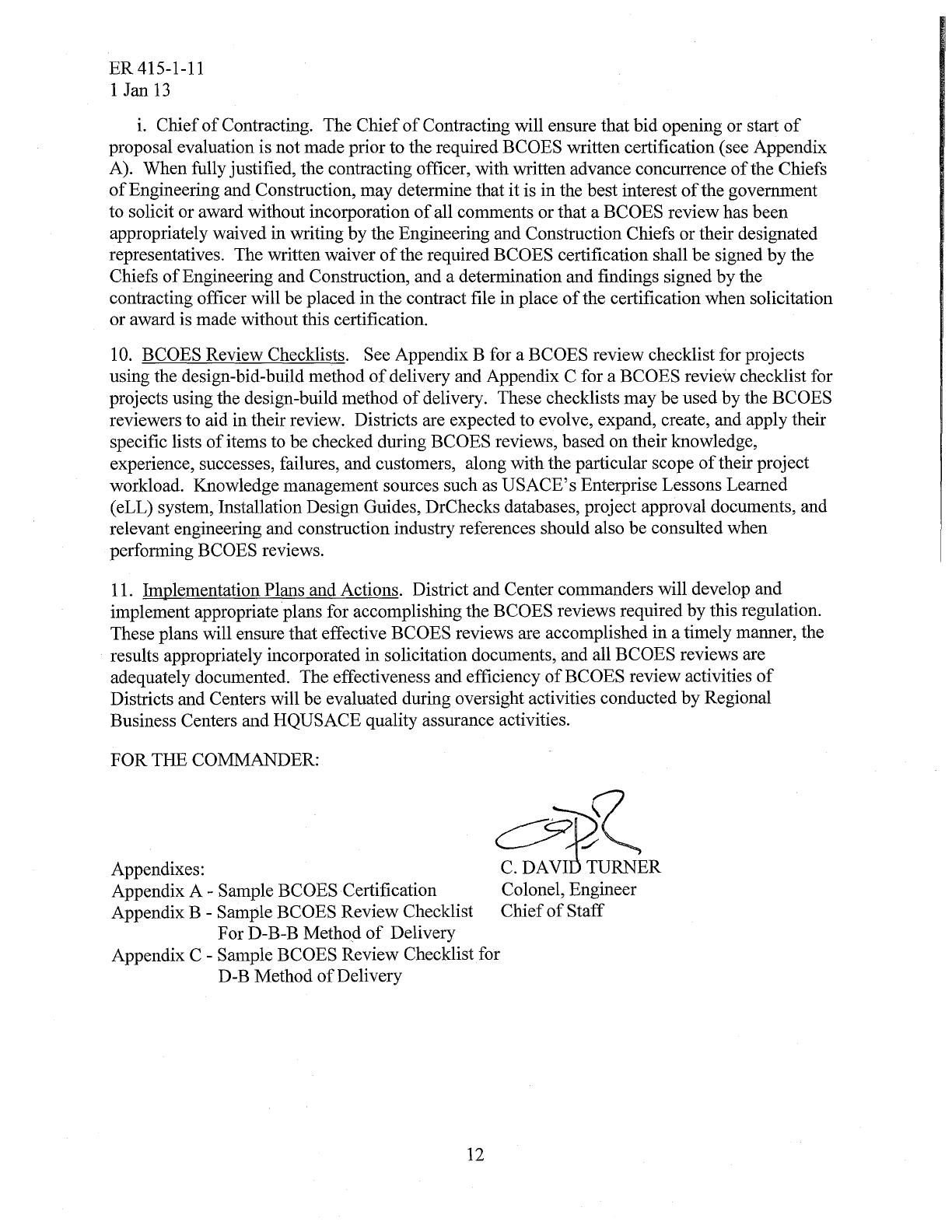
CECW-CE
Regulation
415-1-11
DEPARTMENT OF THE ARMY
U.S. Army Corps of Engineers
Washington, DC 20314-1000
ER 415-1-11
1 January 2013
Engineering and Construction
BIDDABILITY, CONSTRUCTABILITY, OPERABILITY,
ENVIRONMENTAL AND SUSTAINABILITY (BCOES)
REVIEWS
Distribution Restriction Statement
Approved for public release; distribution is unlimited.

i
DEPARTMENT OF THE ARMY
ER 415-1-11
U.S. Army Corps of Engineers
CECW-CE
Washington, DC 20314-1000
Regulation
No. 415-1-11
1 January 2013
Engineering and Construction
BIDDABILITY, CONSTRUCTABILITY, OPERABILITY,
ENVIRONMENTAL AND SUSTAINABILITY (BCOES) REVIEWS
TABLE OF CONTENTS
Paragraph Page
1. Purpose ........................................................................................................................................1
2. Applicability ...............................................................................................................................1
3. Distribution .................................................................................................................................1
4. References ...................................................................................................................................1
5. Definitions...................................................................................................................................2
6. Policies ........................................................................................................................................2
7. Specific Content of BCOES Review Activities ..........................................................................6
8. BCOES Reviews for Projects Using the Design-Build (D-B) Method of Delivery (MOD) ......8
9. Roles and Responsibilities for BCOES Reviews ......................................................................10
10. BCOES Review Checklists .....................................................................................................12
11. Implementation Plans and Actions .........................................................................................12
Appendixes
Appendix A – Sample BCOES Certification .............................................................................. A-1
Appendix B – Sample BCOES Review Checklist for D-B-B Method of Delivery.....................B-1
Appendix C – Sample BCOES Review Checklist for D-B Method of Delivery.........................C-1

DEPARTMENT OF THE ARMY
ER 415-1-11
U.S. Army Corps of Engineers
CECW-CE
Washington, DC 20314-1000
Regulation
No. 415-1-11
1 January 2013
Engineering and Construction
BIDDABILITY, CONSTRUCTABILITY, OPERABILITY,
ENVIRONMENTAL AND SUSTAINABILITY (BCOES) REVIEWS
1. Purpose. The purpose of this regulation is to establish policy and systematic procedures for
conducting effective reviews of a project’s Biddability, Constructability, Operability,
Environmental, and Sustainability (BCOES) characteristics. These reviews are done during
design for a project using the design-bid-build (D-B-B) method or during development of the
request for proposal (RFP) for a design-build (D-B) project. The BCOES review results are to
be incorporated into the procurement documents for all construction projects.
2. Applicability. This regulation applies to all U.S. Army Corps of Engineers (USACE)
organizations that perform design or award or administer contracts requiring construction or
design-build (D-B) construction activities.
3. Distribution. Approved for public release, distribution is unlimited.
4. References.
a. Engineering Regulation (ER) 5-1-11 U.S. Army Corps of Engineers Business Process
b. ER 1110-1-12 Engineering and Design Quality Management
c. ER 1110-1-8159 Engineering and Design DrChecks
d. ER 1110-2-1150 Engineering and Design for Civil Works Projects
e. ER 1110-2-1156 Engineering and Design Safety of Dams Policy and Procedures
f. ER 1110-345-100 Engineering & Design Policy for Military Construction
g. ER 1180-1-6 Contracts – Construction Quality Management
h. ER 1180-1-9 Contracts – Design-Build Contracting
i. ER 11-1-321 Army Programs – Value Engineering
j. Engineer Circular (EC) 1165-2-214 – Civil Works Review
k. Enterprise Standard-08020 Biddability, Constructability, Operability and Environmental
Review

ER 415-1-11
1 Jan 13
2
5. Definitions. Biddability, Constructability, Operability, Environmental and Sustainability
(BCOES) Considerations.
a. Biddability is defined as the clarity of the acquisition documents, the soundness of the
government’s evaluation and selection criteria for negotiated acquisitions, and the ease of
bidders or proposers to understand the government’s requirements, allowing the submission of a
competitive bid or proposal that is responsive to the government’s requirements.
b. Constructability is defined as the ease of constructing a specified or designed project
according to the government’s requirements, including the proposed construction duration, and
the ease of understanding and administering the contract documents during their execution.
c. Operability is defined as the ability to efficiently operate and maintain a facility or
facilities over their life cycle when the facility or facilities are built according to the project’s
plans and specifications.
d. Environmental is defined as the ability to best achieve stewardship of air, water, land,
animals, plants, and other natural resources when constructing and operating the project, and
complying with the Environmental Impact Statement or Assessment or other environmental-
related project requirements. The USACE Environmental Operating Principles (EOPs) in ER
200-1-5 provide direction on achieving synergy between the environment and the execution of
projects. The Environmental part of a BCOES review shall address all EOPs including
compliance with all applicable local, state, and Federal environmental requirements.
e. Sustainability is defined as using methods, systems, and materials that optimize
incorporation of a site’s natural land, water, and energy resources as integral aspects of the
development and minimize or avoid harm to the air, water, land, energy, human ecology and
nonrenewable resources on- and off-site of the project.
6. Policies.
a. Emphasis on BCOES Considerations Throughout Project’s Life Cycle. The value of
BCOES reviews is based on minimizing problems during the construction phase through
effective checks performed by knowledgeable, experienced personnel prior to advertising for a
contract. Biddability, constructability, operability, environmental, and sustainability
requirements must be emphasized throughout the planning and design processes for all programs
and projects, including during planning and design charrettes. This will help to ensure that the
government’s contract requirements are clear, executable, and readily understandable by private-
sector bidders or proposers. It will also help ensure that the construction may be done efficiently
and in an environmentally sound manner, and that the construction activities and projects are
sufficiently sustainable. Finally, effective BCOES reviews of design and contract documents
will reduce risks of cost and time growth, unnecessary changes and claims, as well as support
safe, efficient, sustainable operations and maintenance by the facility users and maintenance
organization after construction is complete.
b. Applicability of BCOES Reviews to Different Methods of Delivery. The BCOES review
processes are applicable to both in-house and Architect-Engineer designs, as well as to requests
for proposals (RFPs) developed for D-B construction contracts, and for task orders under
indefinite delivery construction contracts. BCOES reviews should also be done on all major
ER 415-1-11
1 Jan 13
3
amendments to solicitations before the amendment is issued to bidders or proposers. The
BCOES review process is necessarily adjusted to fit different methods of delivery and different
types of projects. However, nothing in this ER or in the BCOES review process should be
interpreted as a substitute for performance of a complete review of each design or RFP for
accuracy, adequacy, quality, sustainability, and interdisciplinary coordination of design and
technical requirements documents as required by ER 1110-1-8155, ER 1110-2-1150, ER 1110-2-
1156, ER 1110-345-100, EC 1165-2-214 and other applicable directives or instructions.
Reviewers will regularly check USACE lessons learned and knowledge management data bases
prior to and during BCOES reviews in order to update their knowledge.
c. Effective Involvement of the Project Delivery Team (PDT) in BCOES Reviews. The
accomplishment of a quality design or development of an effective RFP package requires the
effective involvement of the entire PDT with project management, engineering, construction,
contracting, real estate, legal, environmental, and operations or installation user/maintenance
personnel each contributing toward a common goal of high quality construction. Errors,
conflicts, disputes, delays, cost and time growth, and operational problems may be minimized
through effective leadership by the project manager and the project’s lead engineer, with
effective involvement of the entire PDT throughout the project delivery cycle.
d. Ensure Involvement of Appropriate and Qualified BCOES Reviewers. Project Managers
will coordinate project reviews at a variety of points during the project’s life-cycle. These
reviews will include the customer and/or using agency (including facility users and facility
operators/maintenance staff), construction, engineering, project management, operations, and
environmental staff to improve the BCOES aspects of designs in the D-B-B method of delivery
and RFPs for D-B construction contracts.
(1) Districts will ensure that the reviewers include construction and operations-maintenance
staff familiar with the project’s location, project site conditions, potential site-related problems,
and plans and requirements for post-construction operations and maintenance. These reviewers
should have extensive knowledge of the construction market place, site and access constraints,
local regulations, facility operations plans and constraints, environmental conditions and
requirements, as well as experience in management of construction projects, determining
construction durations, scheduling construction trades and activities, and experience in the
operations-maintenance of facilities.
(2) The BCOES reviewers also should understand any unique problems and the application
of design assumptions, principles, and specifications during construction and operation.
Temporary assignment of construction or operations staff to the project design work prior to their
assignment at the project site during construction will benefit both the design and the
construction phases of the project.
(3) Construction and maintenance-operations staff inputs are necessary and highly beneficial
early in the design process to allow effective consideration and incorporation of their
recommendations during design or RFP development. Their reviews are also highly beneficial
after final design and coordination reviews when the entire solicitation package is ready for
advertisement, but sufficiently prior to advertisement to allow corrections in the solicitation
documents prior to sending it to industry.

ER 415-1-11
1 Jan 13
4
e. Scheduling of BCOES Reviews for Design-Bid-Build Project Delivery. Three specific
BCOES reviews will be performed for projects using the Design-Bid-Build method of delivery.
An additional review is required when design has been completed and reviewed, but release to
prospective bidders has been held in abeyance for a period of time exceeding 6 months from the
end of the last BCOES review.
(1) The initial BCOES review for projects using the D-B-B method of delivery will be made
at the concept stage or at the on-board review stage when design process cannot be stopped
(Military Programs) and after the design is sufficiently complete for substantive comment (Civil
Works) (e.g., after basic criteria decisions are recorded in the Design Documentation Report).
(2) The second BCOES review for projects using the D-B-B method of delivery will be
made at the final design stage when complete specifications including contract and special
clauses are developed and fully incorporated in the solicitation documents, at least 30 calendar
days prior to advertisement.
(3) The final BCOES review for projects using the D-B-B method of delivery will be a
backcheck review (see paragraph g. below).
(4) Typically, the BCOES review period for large multi-discipline projects using the D-B-B
method of delivery should be about 10 calendar days for the first (concept or on-board) BCOES
review, about 21-30 calendar days for the second BCOES review, and about 15 calendar days
allowed for back checking of comments. Additional BCOES reviews may be held at various
stages of the Planning-Engineering-Design (PED) phase as determined by the lead engineer or
project manager. The schedule durations for BCOES reviews for smaller, single-discipline
projects would be less, and should be tailored to the project’s complexity and staffs’ capacities.
(a) In all cases, the Project Manager will ensure that BCOES reviews are mandatory parts of
the Project Management Plan (PMP) and the PM will allocate adequate time and funding to
conduct the needed BCOES reviews. The specific time and resources will be negotiated among
the Project Manager and the PDT members and included in the Project Management Plan.
(b) The Project Management Plan schedule will reflect the BCOES review requirements
mentioned above and durations of BCOES review times will not be arbitrarily adjusted due to
revisions in design schedules or RFP preparation schedules.
(5) Design-Build (D-B) Method of Delivery (MOD). See paragraph 8 in this ER for
sequence and scheduling of BCOES reviews for projects using the D-B method of delivery.
f. Use of DrChecks for BCOES Reviews. The BCOES reviewers shall use Dr Checks to
transmit their comments to the comment evaluators. DrChecks facilitates and documents the
formal review of project documents and it is a module in the ProjNet (www.projnet.org) suite of
tools developed by USACE’s Construction Engineering Research Lab. The comment evaluators
shall also use DrChecks to reply to the BCOES comments. The BCOES comment submitters
shall read the reply of the comment evaluators and shall either backcheck their comments or get
with the comment evaluator and Project Lead Engineer to find a mutually acceptable solution to
the BCOES reviewer’s comment and then backcheck their comment.
ER 415-1-11
1 Jan 13
5
g. Requirement to Conduct a BCOES Backcheck Review for Certification Prior to Bid
Opening or Start of Proposal Evaluation. A BCOES backcheck will be performed by designated
staff in Engineering and Construction Divisions (or their equivalent) prior to bid opening or start
of proposal evaluation to ensure that all appropriate BCOES review comments have been
incorporated or resolved. This backcheck review should be started 30 calendar days prior to
advertising, and all comments shall be resolved prior to bid opening or proposal evaluation. This
review will serve as the basis for the certification required by paragraph 9 of this regulation. See
Appendix A for a Sample BCOES Certification.
h. Resolution of Disputed Comments. Unresolved BCOES comments that cannot be agreed
upon by the review team will be elevated promptly to the appropriate Section, Branch, or
Division Office Chiefs for resolution.
i. Waiver of BCOES Reviews for Small Projects. If a construction project is small (defined
as having a value less than the simplified acquisition procedures threshold of $150,000) and does
not involve significant risks or complexities, a waiver of the requirement to conduct BCOES
reviews may be requested or proposed by the PM to the Engineering and Construction Chiefs.
(1) The waiver must cite the project’s characteristics that make it appropriate to consider a
waiver of the BCOES requirements. An example of a project that may be appropriate for
submission of a BCOES review waiver request is a $50,000.00 re-roofing construction project on
an existing facility using known materials, standard technical specifications, and standard
acquisition procedures-documents that have been proven successful in their use during the recent
past.
(2) All BCOES waivers requests and approvals of BCOES waivers shall be done in writing
and in advance, and documented in the project file and contract file, as appropriate.
j. Streamlining of BCOES Reviews for Military Overseas Contingency Operations (OCO)
Projects. The exigent nature of some OCO projects may require tailoring of the BCOES review
process to adapt to the capabilities and needs of the organizations performing the BCOES review
and the project delivery schedule. Durations of the review phases may be compressed and
different criteria will be appropriate for the BCOES considerations of these specialized projects.
However, the need and benefits of disciplined BCOES reviews remain high for OCO projects
and these BCOES reviews shall be incorporated into the PMP and performed as required by this
ER.
k. Certification of Value Engineering Study Compliance. BCOES certification shall include
certification by the assigned PM and confirmation by the District Value Engineering Officer that
all statutory and regulatory requirements for Value Engineering (VE) for the project have been
completed and results incorporated, or waived by legal waiver authority (see reference 4.i. and
Appendix A).
l. BCOES reviews for projects subject to the requirements of ER 1110-2-1156 and/or EC
1165-2-214 require careful coordination with the review processes specified therein to avoid
duplication of effort and to implement intended roles and responsibilities. For example, the
purpose and scope of the BCOES review is different from an Agency Technical Review (ATR).

ER 415-1-11
1 Jan 13
6
7. Specific Content of BCOES Review Activities. The BCOES reviews will analyze specific
aspects of the Government’s requirements documents and criteria. The following describes the
specific activities, documents, and aspects of the acquisition that must be reviewed during
BCOES reviews.
a. Biddability Review. All biddability reviews will analyze the completeness, correctness,
compatibility, clarity, and consistency of the collection of plans, specifications, clauses, forms,
bid schedule, and other documents and references that comprise the total solicitation package and
the planned contract. The government is responsible for determining its requirements, and the
solicitation package should be prepared to help bidders or proposers understand clearly the
government’s requirements and to allow the submission of a competitive bid or proposal that is
responsive to the government’s requirements. The biddability review will also include an
evaluation of the soundness of the evaluation criteria that are planned for negotiated acquisitions.
b. Constructability Review. In general, the constructability review includes checking the
compatibility of the design and invitation for bids document or technical aspects of the D-B RFP
with site conditions, materials, equipment, schedules, utility connections, government estimates,
and construction methods relevant to the planned construction. It also includes evaluation of
safety considerations and other planned project and contract features for their ease of successful,
safe execution.
(1) All constructability reviews will include a Plan-In-Hand site visit and review by
appropriate Area/Resident Engineer staff to ensure all visible and known existing characteristics
of the site described in the project design and acquisition documents are included, accurate, and
supportive of the project’s successful acquisition and construction. Contractor office and storage
areas will be among the items checked. Also, for projects involving acquisition of any real estate
interest, coordination will be made with the applicable Chief of Real Estate to ensure all
necessary real estate interests to accommodate all aspects of the planned work are available.
(2) All constructability reviews will also specifically review the planned construction
phasing, sequencing, and period of performance for the contract to ensure that an adequate
construction period is specified. While many designers may initially develop this construction
duration, the final evaluation of the adequacy of the specified period properly rests with the
construction Area/Resident Engineer to review and concur with the period of performance or to
determine if accelerated efforts will be required for a contractor to achieve an aggressive
construction schedule. The planned contract’s requirements for scheduling systems and quality
control also will be checked as part of the constructability review.
(3) The constructability review also needs to evaluate if the procedures used for
development of the bid schedule and independent government estimate (IGE) comply with
policies, and account for items such as accelerated construction, pre-priced contract line items,
and other constructability impacts on the estimated cost for the construction. Additionally, the
constructability review will include a review of the basis for calculating any liquidated damages
for the project, including validation of any projected estimated additional expenses that would be
incurred by the facility customer-user.
ER 415-1-11
1 Jan 13
7
c. Operability Review. Review of the operability of the facility or facilities to be constructed
must include a good understanding and detailed consideration of the customer’s-owner’s
operations and maintenance requirements, needs, practices, and capabilities after construction
completion and turnover. The Area/Resident Engineer staff should jointly conduct an operability
review with the facility’s planned user(s) and maintainers as a means of improving mutual
understanding and planning for the upcoming construction and facilitating the successful transfer
and understanding of the operability comments by the USACE PDT. The operability review
should include a check of all commissioning requirements, transfer and handover documentation
requirements, and warranty requirements and plans.
(1) For Civil Works projects, the review will include evaluation of Plans, Specifications,
Engineering Considerations and Instructions for Field Personnel (ECIFP) reports (see reference
4.b., Chapter 7), the operations, maintenance, repair, replacement, and rehabilitation (OMRR&R)
plan for the project, and other required documents.
(2) For Civil Works projects, the District’s Operations staff should lead the operability
review of the planned project, with contributions from other BCOES reviewers. For Military
Mission projects, the planned owner-operator-maintainer community such as the facility user and
the installation Director of Public Works (DPW) or Base Civil Engineer (BCE) should lead the
operability review of the planned project, with contributions from other BCOES reviewers.
d. Environmental Review. Review of the compliance of the project’s design, construction,
and operation with all applicable environmental laws and regulations, including Environmental
Operating Principles (EOPs) in ER 200-1-5, is included in BCOES reviews. The environmental
review will address the project’s compliance with all applicable local, state, and Federal
environmental regulations and requirements, including National Pollutant Discharge Elimination
System (NPDES) permits, required permits for earth disturbance, stormwater management, etc.,
and reports or requirements for any asbestos, lead paint, and other hazardous materials handling ,
removal, and disposal. Archeological, historical, hazardous, toxic, and radioactive waste
(HTRW), and military munitions concerns that may impact the project’s execution during the
acquisition and construction phases are also addressed during this review. The District’s
environmental, regulatory, operations, and construction staffs should be engaged in this review
for CW projects, and the installation’s environmental, public works, and the District’s
construction staffs should perform this review for military projects.
e. Sustainability Review. Review of the sustainability of the project to be acquired must
include a good understanding and detailed consideration of the Federal Guiding Principles for
High Performance Sustainable Buildings and compliance with other applicable laws, regulations,
polices, standards, codes and criteria for sustainability related to facilities and infrastructure. The
review should include, but is not limited to application of integrated design principles; energy
performance optimization; water protection and conservation; indoor environmental quality;
and the environmental impact of materials (including green purchasing and diverting wastes
from landfill); facility siting and orientation; building size and layout; stormwater runoff
during and after construction; sourcing and durability; transportation; and certification of
facility performance regarding sustainability. The sustainability reviewers should include

ER 415-1-11
1 Jan 13
8
engineering and operations staffs of the using organization as well as the District’s LEED,
Sustainability and construction staff members.
8. BCOES Reviews for Projects Using the Design-Build (D-B) Method of Delivery (MOD).
a. Overview of BCOES in D-B. The D-B MOD combines design and construction within a
single construction contract and uses competitive evaluation of technical and price proposals to
select a contractor to design and build the project. Design by the D-B contractor usually is done
before and sometimes during construction activities under the D-B contract. When parts of the
design are being developed concurrent with construction activities, this is termed a “fast-track”
approach. In contracts using the D-B MOD, final design solutions are provided by the D-B
contractor who is responsible for their own design, construction quality, and for full compliance
with the RFP and the selected contractor’s proposal. After award of a D-B contract, the USACE
organization managing the project and administering the contract will review the D-B
contractor’s design for compliance with the quality and design intent of the RFP and the terms of
the selected proposal by the contractor, as incorporated into the awarded contract.
b. Levels of Technical Criteria in D-B RFP. The Government’s Requests for Proposal for a
D-B acquisition will state project requirements, criteria, and evaluation factors. The D-B RFP
may be prepared using various levels of technical criteria to state the project’s requirements.
Individual projects may be consistent in their level of technical criteria in the RFP, or a particular
project may have varying levels of technical criteria depending upon the specific requirements of
the various technical areas, disciplines, features, and customer needs.
(1) One level of technical criteria under D-B is nominal criteria where the Government
essentially uses an almost total performance specification, stating the purpose, function, and
characteristics of the project in sufficient detail to delineate and characterize functional features
and the visual appearance of the project.
(2) A second level of technical criteria for a D-B RFP is partial criteria where the
Government prepares concept floor plans (or their equivalent facility definition) which indicate a
special mechanical and electrical equipment layout, overall dimensions, and desirable column
locations. Enlarged floor plans are provided, as required, to explain special design conditions.
Minimum requirements for mechanical and electrical equipment layouts, including provisions
for testing, adjusting, balancing and commissioning, should be specified. Preliminary exterior
elevations and cross sections are provided for special design requirements. A site plan is
provided to indicate the building orientation and circulation to the building entrances.
(3) A third level of technical criteria for a D-B RFP is full criteria where the Government
uses a more prescriptive approach to the design and construction, and prepares enlarged floor
plans (or their equivalent facility definition) which indicate a special mechanical and electrical
equipment layout, fire protection information, overall dimensions, desirable or required column
locations or other structural features, and typical wall sections to indicate materials usage.
Requirements for testing, adjusting, balancing and commissioning would be specified. A
preliminary site plan, landscaping plan, exterior elevations, cross sections, floor plans, finish
schedule, door schedule, foundation, framing plan, and sections would typically be provided by
ER 415-1-11
1 Jan 13
9
the Government in the full criteria approach to D-B MOD. In many cases, the full criteria
approach may only apply to critical project elements or features. In other cases, such as in “site-
adapt” D-B, the criteria may resemble many parts of a complete design.
c. Timing of BCOES Reviews Under D-B. For D-B RFPs using nominal, partial, or full
criteria, the initial BCOES review will be made after the technical criteria are sufficiently
complete for substantive comments.
(1) This initial BCOES review may be best accomplished as a combined on-board functional
review by senior representatives from applicable functional areas or various disciplines.
(2) The second BCOES review will be performed as part of the review of the completed
RFP package prior to it being released to industry. This review will include the requirements of
the proposal evaluation and source selection policies and plans. For MILCON projects using
directive controls, the certification of the BCOES review occurs prior to the District taking credit
for achieving the Ready to Advertise (RTA) milestone (i.e., posting the actual RTA date in P2
system) and HQUSACE issuance of Code A authority to advertise.
(3) After award of the D-B contract and during the design phase, BCOES-type
considerations will be included as part of the contractor’s QC process and the Government’s QA
evaluation of the contractor’s preliminary and final design documents. These post-award
reviews are not formal BCOES reviews, but are part of the overall contract administration and
quality management processes for D-B contracts.
d. Focus of BCOES Reviews For D-B RFPs. The BCOES review will focus on the clarity of
Government D-B requirements in the RFP versus the project’s requirements in the project
approval documents; the inclusion of needed, appropriate constraints in the RFP and the absence
of unneeded, inappropriate ‘designability’ and constructability constraints in the RFP; the
appropriateness and soundness of the planned proposal evaluation criteria; the clarity and
completeness of operability requirements in the performance specifications; clarity and
completeness of addressing environmental constraints and requirements in the performance
specifications; and clarity, completeness, appropriateness of the sustainability aspects of the
performance specifications, and the inclusion of appropriate FAR clauses for green purchasing.
Use of the D-B method of delivery creates highly variable levels of design detail among projects.
However, the BCOES review of the RFP remains necessary, and the review must be tailored to
the D-B MOD, the use of nominal, partial, or full criteria, and other key project characteristics.
e. Scheduling of BCOES Reviews for Projects Using D-B Method of Delivery. The project
management plan for projects using the D-B MOD will reflect the BCOES review requirements
established above and will allocate adequate time and funding to conduct effective BCOES
reviews appropriate for the D-B MOD. BCOES considerations should be an important part of
the initial development of functional requirements for the D-B RFP.
(1) The initial BCOES review should be allocated at least 21 calendar days in the PMP for
project RFPs using nominal or partial technical criteria, and at least 30 calendar days for project
RFPs using full technical criteria.

ER 415-1-11
1 Jan 13
10
(2) The second BCOES review should be allocated at least 14 calendar days for project
RFPs using nominal or partial technical criteria, and at least 21 calendar days for project RFPs
using full technical criteria.
(3) During the design phase of the D-B contract execution, weekly ‘over the shoulder’
(OTS) conformance reviews by government staff of design development products by the
contractor are recommended to ensure the appropriate BCOES considerations required by the
awarded contract are incorporated into the design documents. These OTS conformance reviews
are especially important in fast-track designs so that sensitive schedules are not delayed or
otherwise negatively impacted.
9. Roles and Responsibilities for BCOES Reviews.
a. Chief of Project Management and Project Manager. The Chief of Project Management at
the assigned District or Center will ensure that adequate time to accomplish these review
activities, as outlined in paragraphs 6.e. and 8.d. above, is included in the project baseline
schedule. Further, they will ensure that adequate design funds for the accomplishment of
BCOES reviews are reserved in the baseline budget as negotiated and included in the Project
Management Plan in accord with ER 5-1-11. The PM assigned to lead the project will rely on
the assistance of the Value Engineering officer, and will ensure that the Value Engineering
process was completed and certified in accord with ER 11-1-321. The assigned PM shall also
ensure timely, effective performance of BCOES reviews and appropriate incorporation of results.
b. Value Engineering (VE) Officer. Upon notification by the responsible PM, the VE officer
will ensure that VE requirements are completed (i.e., studied or waived) for projects. The VE
officer will verify that all rejected VE proposals indicating potential savings over $1,000,000
have been resolved with approval of the MSC Commander. As required, the District VE officer
will sign the appropriate Value Engineering certification (sample at Appendix A) prepared by the
assigned PM for the project. Contracting officers shall not advertise projects that do not have the
required VE Certification completed, so the BCOES review is critical to ensuring this step is
done.
c. Chief of Engineering (or equivalent) and Lead Engineer for the Project. The Chief of
Engineering for the District/Center performing the design or developing the RFP will ensure that
effective BCOES reviews are systematically accomplished and that the resulting comments are
incorporated or resolved in a timely manner. The lead engineer for a project will ensure that
appropriate documents are provided for review and backcheck to the BCOES reviewers, that all
BCOES review comments are evaluated, and that timely feedback on disposition of comments is
provided. The Chief of Engineering for the District/Center or a duly authorized representative,
Branch Chief or higher, will certify in writing that all appropriate BCOES review comments
have been incorporated in the bid or request for proposal documents, or satisfactorily resolved,
and that all BCOES comments, evaluations, and backchecks are documented in DrChecks. The
Chief of Engineering for the District/Center will review and act on all appropriate requests for
waiver of BCOES reviews for small, low risk projects.
(1) For non-CW projects, some Districts have environmental engineering capabilities in their
Engineering Division/Branch, and they may be an appropriate source for environmental and
sustainability considerations in BCOES reviews.
ER 415-1-11
1 Jan 13
11
(2) Similarly, some of the larger Construction staffs may have significant environmental and
sustainability expertise from training, education and experience, and may be fully capable of
performing an effective environmental and sustainability review of the IFB/RFP package as part
of an overall BCOES review.
d. Chief of Construction (or equivalent) and Area/Resident Engineer for the Project. The
Chief of Construction (or equivalent) will ensure that BCOES reviews for biddability,
constructability, and operability are performed in a timely manner, including coordinating
operability reviews, that review comments are furnished in accord with established suspense
dates, and that a backcheck is conducted. The Chief of Construction or a duly authorized
representative, Branch Chief or higher, will certify in writing that all appropriate BCOES
comments have been incorporated in the bid or request for proposal documents or satisfactorily
resolved, and that all comments, evaluations, and backchecks are documented in DrChecks. The
Chief of Construction for the District/Center will review and act on all appropriate requests for
waiver of BCOES reviews for small, low risk projects. The Area or Resident Engineer for the
project will ensure that qualified field office staff are trained, assigned, and conducting effective
BCOES reviews for all projects planned to be constructed in their office’s area of operations.
e. Chief of Real Estate. For projects involving real estate matters or acquisition of any real
estate interest (e.g., purchase, leasehold, easement, etc.), the Chief of Real Estate will ensure that
BCOES reviews for compliance with all real estate requirements are performed in a timely
manner, that review comments are furnished in accord with established suspenses, and that a
backcheck is conducted in DrChecks. If the project involves acquiring any real estate interest,
the Chief of Real Estate or a duly authorized representative, Branch Chief or higher, will certify
in writing that all necessary real estate interests to accommodate all aspects of the planned work
are available or provided for in the planned solicitation.
f. Chief of Planning. For Civil Works projects, the Chief of Planning will ensure that
BCOES reviews for environmental considerations are performed in a timely manner, that review
comments are furnished in accord with established suspenses, and that a backcheck is conducted.
For Civil Works projects, the Chief of Planning or a duly authorized representative, Branch
Chief or higher, will certify in writing that all appropriate BCOES review comments have been
incorporated in the bid or RFP documents or satisfactorily resolved and that all comments,
evaluations, and backchecks are documented in DrChecks.
g. Chief of Operations. For Civil Works projects, the Chief of Operations will ensure that
BCOES reviews for operability are performed in a timely manner, that review comments are
furnished in accordance with established suspenses, and that a backcheck is conducted. For Civil
Works projects, the Chief of Operations or a duly authorized representative, Branch Chief or
higher, will certify in writing that all appropriate BCOES comments have been incorporated in
the bid documents or satisfactorily resolved and that all comments, evaluations, and backchecks
are documented in DrChecks.
h. Installation Director of Public Works (DPW) and Base Civil Engineer (BCE). For
military mission projects, the responsible Area/Resident Engineer will coordinate with the
appropriate installation DPW or BCE (or equivalent) to ensure that BCOES reviews for
operability are performed in a timely manner and that review comments are furnished in
DrChecks in accord with established suspenses.

ER415-1-11
1 Jan
13
i.
Chief
of
Contracting. The Chief
of
Contracting will ensure that bid opening or start
of
proposal evaluation is not made prior to the required BCOES written certification (see Appendix
A). When fully justified, the contracting officer, with written advance concurrence
ofthe
Chiefs
of
Engineering and Construction, may determine that it is in the best interest
of
the government
to solicit or award without incorporation
of
all comments or that a BCOES review has been
appropriately waived in writing by the Engineering and Construction Chiefs or their designated
representatives. The written waiver
of
the required BCOES certification shall be signed
by
the
Chiefs
of
Engineering and Construction, and a determination and findings signed by the
contracting officer will be placed in the contract file in place
of
the certification when solicitation
or award is made without this certification.
10.
BCOES Review Checklists. See Appendix B for a BCOES review checklist for projects
using the design-bid-build method
of
delivery and Appendix C for a BCOES review checklist for
projects using the design-build method
of
delivery. These checklists may be used by the BCOES
reviewers to aid in their review. Districts are expected to evolve, expand, create, and apply their
specific lists
of
items to be checked during BCOES reviews, based on their knowledge,
experience, successes, failures, and customers, along with the particular scope
oftheir
project
workload. Knowledge management sources such as
USACE's Enterprise Lessons Learned
(eLL) system, Installation Design Guides, DrChecks databases, project approval documents, and
relevant engineering and construction industry references should also be consulted when
performing
BCOES reviews.
11. Implementation
Plans and Actions. District and Center commanders will develop and
implement appropriate plans for accomplishing the
BCOES reviews required by this regulation.
These plans will ensure that effective
BCOES reviews are accomplished in a timely manner, the
results appropriately incorporated in solicitation documents, and all
BCOES reviews are
adequately documented. The effectiveness and efficiency
ofBCOES
review activities
of
Districts and Centers will be evaluated during oversight activities conducted by Regional
Business Centers and
HQUSACE quality assurance activities.
FOR THE COMMANDER:
~I?~
C.
DAVI'J~URNER
Appendixes:
Appendix A - Sample
BCOES Certification
Appendix B - Sample
BCOES Review Checklist
For D-B-B Method
of
Delivery
Appendix C - Sample
BCOES Review Checklist for
D-B Method
of
Delivery
12
Colonel, Engineer
Chief
of
Staff
ER 415-1-11
1 Jan 13
A-1
APPENDIX A
Sample BCOES Certification
Name of Project/Project Number: ____________________________/________________
Phase or Type of Project: ____________________________
Certification Date: ____________________________
I, (the PM), certify that the Value Engineering process as required by ER 11-1-321 (Change 1 or
latest version), Army Programs Value Engineering has been completed for this procurement
action. I certify compliance with Public Law 99-662 (33 USC 2288) and OMB Circular A-131.
A VE study was (completed/waived) on (date) by the appropriate authority. All rejected VE
proposals indicating potential savings of over $1,000,000 have been resolved with approval of
the MSC Commander.
_______________________________ _______________________________
Assigned Project Manager (dd/mm/yr) Value Engineering Officer (dd/mm/yr)
The Bid or RFP Package has been reviewed for Biddability, Constructability, Operability,
Environmental, and Sustainability (BCOES) requirements in accord with ER 415-1-11. The
undersigned certify that all appropriate BCOES review comments have either been
incorporated into the Bid or RFP Package or otherwise satisfactorily resolved. Comments,
evaluations, and backchecks are documented in DrChecks.
____________________________ ____________________________
Chief, Engineering (dd/mm/yr) Chief, Construction (dd/mm/yr)
____________________________ ____________________________
Chief, Planning (when appropriate) Chief, Operations (when appropriate)
______________________________
Chief, Real Estate (when appropriate)

ER 415-1-11
1 Jan13
B-1
APPENDIX B
Sample BCOES Review Checklist for Design-Bid-Build Method of Delivery
BCOES Checklist – D-B-B Method
Project Title & Location:
Project Review Phase:
Date of Documents Reviewed:
Reviewer Name & Phone:
Review Date:
Item
Number
Section for
Review
Y N NA
Biddability, Constructability, Operability, Environmental, and Sustainability
1
Is the scope of the project consistent with authorizing legislation
and program regulations?
2
Is scope of the project as reflected by the plans & specs consistent
with the approved authorizing document for the project?
3
Do plans and specs incorporate the customer's stated needs and
objectives?
4
Are assumptions made during project development consistent with
legislation, approved project documentation, and were they
reviewed with local interests?
5
Does the acquisition strategy and method of delivery appear
appropriate for the project?
6
Is scope of construction clear in the project plans and specs?
7
Are special installation requirements for the Government and/or
the Contractor appropriately addressed?
8
Is construction phasing clear, feasible, and appropriate?
9
Is the size and configuration of proposed facilities expected to
function as intended and meet stated project requirements?
Mission goals?
10
Is the CWE and appropriate contingency covered by a funded
PRC? Do they conform to project approval documents?
11
Are there conflicts in the specs regarding Measurement and
Payment and Contract Line Items in Bid Schedule?
12
Is the measurement and payment section complete and clear?
13
Can the quantity of all items be estimated and verified?
14
Are the CLINs consistent in the Bid Schedule?
15
Are the CLINs appropriately linked to specification sections and
definable features of work in the contract?
16
If options are included, are limits of work associated with each bid
option clearly defined?
17
If options are used, is the time for the award of options explicitly
specified?
18
Has consideration been given to whether the option work is
independent of other work?
19
Should payment for offsite stored materials be permitted, and is
the appropriate clause in solicitation?
20
Check bid forms to assure bid schedule is simple, clear, and
includes all necessary items of work.
21
Are estimated quantities reasonable?
22
Do drawings contain definite, definable pay lines for computing
quantities in CY, CF, SY, SF, etc…?

ER 415-1-11
1 Jan 13
B-2
Sample BCOES Review Checklist for Design-Bid-Build Method of Delivery (continued)
Item
Number
Section for
Review
Y N NA
Biddability, Constructability, Operability, Environmental, and Sustainability
23
If estimated quantity is uncertain and expected to vary
substantially, use subdivided items per EFARS/UAI ( i.e.,
excavation, dredging, fill stone, rock excavation, etc.)
24
Check specifications to assure that work components of lump sum
item are clearly defined.
25
Check specifications to assure payment paragraph is also a lump
sum item if CLIN is for lump sum amount.
26
Check drawings to assure that lump sum items and the quantity
for unit price items are not overlapping.
27
Are contract sequencing and relations to other work appropriate?
28
Are contract performance time, submittal schedule, and quality
control system adequately defined?
29
Are specifications and plans consistent with each other?
30
Do the specifications list submittals needed to effectively
administer the contract (ER 415-1-10)?
31
Are submittals types (e.g., FIO, GA, etc.) appropriately
categorized in accord with ER 415-1-10?
32
Does the contract have any unreasonable requirements for
Government inspections?
33
Are special installation requirements appropriately addressed?
34
Are quality control and quality assurance appropriately addressed
within the contract documents?
35
Are there ambiguous requirements or exculpatory type clauses for
which the designer should be more descriptive?
36
Is this construction contract consistent with the FAR, DFARS,
AFARS, EFARS/UAI?
37
Is a conflict resolution process appropriately defined?
38
Is coordination on the location of existing utilities and their
relocation, if required during construction, clear and complete?
39
Are testing, balancing, commissioning and certifications
addressed adequately?
40
Are O&M manuals/videos, training, spare parts, keys, warranties,
warranty response times and sources, as-built drawings, and
transfer of O&M data from the construction phase appropriately
addressed?
41
Do contract documents include all applicable permits to operate
facility (if required)?
42
Are project and public safety measures adequately addressed?
43
Do Spec Sections adequately & accurately reference EM 385-1-1?
44
Are abbreviations and nomenclature consistent with construction
needs?
45
Is there a consistent system used for indicating sections and
details?
46
Are title blocks consistent and properly filled out?

ER 415-1-11
1 Jan13
B-3
Sample BCOES Review Checklist for Design-Bid-Build Method of Delivery (continued)
Item
Number
Section for
Review
Y N NA
47
Confirm that all major items can be located from data supplied on
drawings.
48
Are adequate horizontal alignment and elevation control reference
points provided?
Biddability, Constructability, Operability, Environmental, and Sustainability
49
Are essential details and proper verbiage included in drawings and
specs?
50
Are exact legal property descriptions shown?
51
Is job site erosion control appropriately addressed?
52
Do the specifications address the impact of the construction on the
environment?
53
Is a submittal required for a contractor prepared environmental
plan? Does it address mitigation of water, air, soil, noise
pollution, other (specify)?
54
Will the project encroach on wetlands or endangered species
habitat?
55
Has the State or local entity been coordinated with and permits
issued as needed?
56
Have we verified compliance with requirements of NEPA?
Specifically, has an EA or EIS been completed, and Record of
Environmental Consideration or Finding of No Significant Impact
been signed by appropriate authority?
57
Are planting and topsoil requirements maintainable and consistent
with the environment?
58
Is erosion control adequately addressed in rivers/streams and along
shorelines?
59
Are staging areas well defined (located and dimensioned)?
60
Are separate staging areas required for work areas separated by
long distances?
61
Are access and haul routes to work site well defined?
62
Do the Engineering Considerations and Instructions for Field
Personnel (ECIFP) Report adequately address construction salient
features?
63
Verify work limits or rights-of-way are shown, well defined and
sufficient for work.
64
Is all work completely within the work limits?
65
Adequacy of working area and storage space, and access for
contractors are addressed?
66
Can periodic inspections be accomplished efficiently and
effectively?
67
Are load restrictions for heavy equipment or water depths
adequate for construction equipment expected on site?
68
Appropriate water level gauges are highlighted and useful for job?
69
Do existing conditions that are mapped depict actual current site
conditions; access, utility availability, drainage, storage area,
existing underground utilities, general site conditions? Has this
accuracy been verified and documented?
70
Are datum correct and coordinate system correct?

ER 415-1-11
1 Jan 13
B-4
Sample BCOES Review Checklist for Design-Bid-Build Method of Delivery (continued)
Item
Number
Section for
Review
Y N NA
Biddability, Constructability, Operability, Environmental, and Sustainability
71
Is survey data current, dated and adequate to show existing site
conditions?
72
Are required and existing conditions clearly defined?
73
Are Levee Safety and Dam Safety issues addressed if required?
74
Have local availability of materials and labor skills been
appropriately addressed?
75
Architectural compatibility with existing facilities and established
installation//base plans is achieved by the design?
76
Are provisions made to collect operations and maintenance data
during the construction phase for transfer to facility user/owner?
77
Are CAD/BIM products compatible with facility user/owner
systems?
78
Is all coordination with any privatized utility provider/owner
accomplished and consistent with the planned contract?
79
Are LEED, Guiding Principles and LID requirements clearly and
appropriately specified in plans and specs? CLINs?
80
Are appropriate Environment & Sustainability FAR clauses and
specs associated with included in the specifications/solicitation?
81
Are warranty provisions clear and enforceable?
82
Is the site clear of any HTRW? Other subsurface obstructions and
hazards?
83
Has a Plan-in-Hand Review been accomplished & documented?
84
Has the operability review been facilitated with the facility
owner/user?
85
Is there a requirement to coordinate the construction activities with
USACE Mandatory Centers of Expertise? If so, is this
coordination clear and compatible with all other parts of the
contract?
86
Has the proposed construction schedule prepared by the designer
of record been reviewed to establish a reasonable contract
performance period to be used in the solicitation?
87
Do solicitation drawings (electronic & paper) comply with current
Geospatial Standards (e.g., SDSFIE 3.0 & A/E/C CADD
Standards 4.0)?
88
Is VECP clause included in contract documents in accord with
FAR provisions?
89
Is signed Value Engineering Certification included in the project
package prior to advertising?
90
Is site clear of military munitions/unexploded ordinance?
91
Have munitions response site inventory, applicable historical
record review & archives search reports records been checked?
92
If military munitions/UXO could be present, has planning been
completed to address explosives safety hazards (either as separate
pre-award munitions response project or inclusion of munitions
and explosives of concern construction (MEC) requirements in
contract clauses?
93
Are there any other outstanding issues?

ER 415-1-11
1 Jan 13
C-1
APPENDIX C
Sample BCOES Review Checklist for Design-Build (D-B) Method of Delivery
BCOES Checklist – D-B Method
Project Title & Location:
Project Review Phase:
Date of Documents Reviewed:
Reviewer Name & Phone:
Review Date:
Item
Number
Section for
Review
Y N NA
Biddability, Constructability, Operability, Environmental, and Sustainability
1
Is the scope of the project consistent with authorizing legislation
and program regulations?
2
Do RFP technical provisions and other documents incorporate the
customer's stated needs and objectives?
3
Are assumptions made during project development consistent with
legislation, approved project documentation, and were they
reviewed with local interests/installation/command ‘customers’?
4
Does the acquisition strategy and method of delivery appear
appropriate for the project?
5
Are technical & evaluation parts of RFP consistent & compatible?
6
Have the existing site conditions (visible and sub-surface,
including underground utilities) been adequately investigated and
clearly/accurately depicted in the RFP’s engineering documents?
7
Is scope of construction clear in the project technical criteria and
engineering documents in the RFP?
8
Are the minimum design criteria for all desired, essential, or
mandatory elements of the project clearly stated in the RFP?
9
Does the RFP clearly state the detailed drawings, project
descriptions, quality, and performance requirements that will be
expected as a complete final design after award of the contract?
10
Is the design review process including required design
submittals/deliverables clearly described in the RFP?
11
Does the RFP clearly state the number of design
submittals/deliverables the D-B contractor must make and
delineate between design submittals to be reviewed only and those
to be reviewed and approved by the Government?
12
Does RFP clearly state when design activity stops & construction
may begin for any particular phase/feature of the project?
13
If the RFP requires design in accord with commercial standards,
codes, & specs, are government PDT members familiar with and
have ready access to all referenced codes, standards, and specs?
14
Are the Federal, DoD, or Installation/Sponsor criteria, codes,
standards, regulations, etc. applicable in part or in whole to the
project clearly indicated in the RFP?
15
Does the RFP specifically and clearly require O&M manuals and
O&M training at the system level?
16
Is the CWE and appropriate contingency covered by a funded
PRC? Does it conform to project approval documents?
17
Do the proposal requirements align clearly and consistently with
the evaluation factors and agree with the project criteria?

ER 415-1-11
1 Jan 13
C-2
Sample BCOES Review Checklist for Design-Build (D-B) Method of Delivery
Biddability, Constructability, Operability, Environmental, and Sustainability
18
Does the RFP include clear, accurate list of submittal requirements?
19
Is construction phasing clear, feasible, and appropriate?
20
Are the appropriate evaluation weights clearly assigned to each of the
evaluation factors in the RFP and the Source Selection Plan?
21
Do the technical specs match the Source Selection Plan and the
submission requirements/instructions in the RFP?
22
Does the RFP contain options that may be used to determine what can
be obtained within available funds?
23
If options are included, are limits of work associated with each bid
option clearly defined? Time for award of options specified?
24
Are the solicitation and contractor performance periods reasonable?
25
Are the technical project criteria compatible and consistent with each
other, and the non-technical portions of the RFP?
26
Should payment for offsite stored materials be permitted, and is
appropriate clause in contract?
27
Does the RFP contain a construction cost limit (combined design and
construction costs)?
28
Does RFP state a maximum construction time? If so, is it reasonable?
29
Does the RFP clearly describe the requirements for building and
systems commissioning, including criteria and lists of systems and
their components?
30
Does the RFP clearly describe the contractor quality control
requirements for all design work? The government QA process for
design work?
31
Does the RFP clearly describe the contractor quality control
requirements for all construction work? The Government QA process
for construction work?
32
Does the RFP clearly describe mandatory Federal requirements for
environmental criteria, standards, and processes?
33
Does the RFP clearly indicated that all buildings identified for
renovation or demolition have been sampled and tested for the
presence of hazardous materials, lead paint, asbestos, etc. either by
the building owner or the USACE?
34
Are all operating and construction permits, permitting actions, and
responsibilities for permits appropriately addressed in the RFP?
35
Are all wetland areas and floodplain limits determined and clearly
delineated on the drawings included in the RFP?
36
Are utility capacity data and tie-in points clearly delineated on
drawings included in the RFP?
37
Are potable water system pressure and capacity data tests done and
the test results provided in the RFP?
38
Are sufficient borings and/or test pits done to delineate general
subsurface conditions and the results provided in the RFP?
39
Are site-specific requirements such as local codes, required materials,
materials restrictions, and work restrictions in the RFP?
40
Is there a requirement to coordinate RFP, design submittals, and/or
construction activities with USACE Mandatory Centers of Expertise?
Is this coordination clear & compatible with all other parts of RFP?
41
Is VECP clause in contract documents IAW FAR provisions?
42
Is signed VE certification included in package before issuing RFP?
43
Are LEED, Guiding Principles, and LID requirements clear & in
CLINs?

ER 415-1-11
1 Jan 13
C-3
Sample BCOES Review Checklist for Design-Build (D-B) Method of Delivery
Biddability, Constructability, Operability, Environmental, and Sustainability
44
Have we verified compliance with requirements of NEPA?
Specifically, has an EA or EIS been completed, and Record of
Environmental Consideration or Finding of No Significant Impact
been signed by appropriate authority?
45
Is site clear of military munitions/unexploded ordinance?
46
Have munitions response site inventory, applicable historical record
review & archives search reports records been checked?
47
If military munitions/UXO could be present, has planning been
completed to address explosives safety hazards (either as separate
pre-award munitions response project or inclusion of munitions and
explosives of concern construction (MEC) requirements in contract
clauses?
48
Does the RFP clearly provide guidance for deviating from any shown
drawings/layouts? For example, proposed building footprint meets
square footage criteria but uses different shape/configuration than
shown in the RFP?
49
For Standard Design Facilities, has applicable Center of
Standardization validated that RFP meets Army Standards and
Standard Designs?
50
Are there any other outstanding issues?
